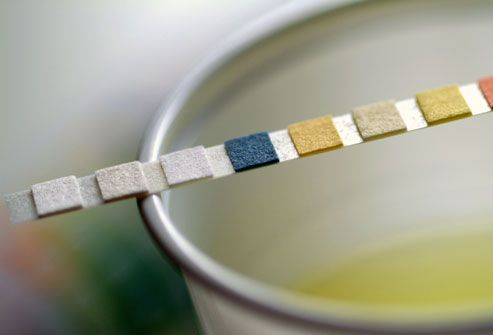Urine testing medical procedure that looks at several characteristics of a person’s urine. Once done, the sample is used to evaluate a person’s general health. It is done to identify possible underlying medical issues while offering important information.
Have you been recently asked to collect your urine sample? With advancement, these days, you can do it at home by yourself. One such diagnostic tool used is urine test strips. Are you wondering what it is? How can you use it? Well, here is your ultimate guide to everything.
What is a Urine Test Strip?
Urine test strips (STS), also known as urine dipstick tests, are diagnostic tools. They are used to examine different urine chemicals and the presence and concentration of particular compounds. Usually, the urine strip has several pads, each of which reacts differently to various urine constituents.
Once used, the colour of the urine test strips changes, indicating different meanings. For instance, typical metrics assessed in a pee strip test are:
- pH: Shows how acidic or alkaline the pee is.
- Protein: Identifies whether there is protein in the urine. This could be a sign of kidney disease or other illnesses.
- Glucose: Checks for elevated urine glucose levels. This indicates diabetes or other metabolic diseases.
- Ketones: Identifies the presence of ketones in the urine. This happens during fasting or in diseases such as diabetic ketoacidosis.
- Bilirubin: Checks for bilirubin. This could be a sign of gallbladder or liver problems.
- Urobilinogen: Determines the level of urobilinogen in the urine. This could be a sign of haemolytic or liver diseases.
- Nitrites: Identifies nitrites in the urine. This could be a sign of an infection in the urinary tract.
- Leukocyte Esterase: Checks for white blood cells in the urine. This could be a sign of inflammation or an infection of the urinary system.
How to Use Urine Test Strips?
Now that you know what urine test strips are, you must be wondering how to use them. Aren’t you? Well, a urine sample is dipped into a plastic strip that has often been coated with chemical reagents. They are a quick and simple way to find out if your pee is infected. For your better understanding, the steps are:
- Pour your urine into a sanitised urine collection container.
- Remove one urine test strip instantly and securely seal the container. For two seconds, dip it into the pee.
- The results could be hampered by any excess that moves between the urine reagents. So, get rid of the extra by tapping the container’s side.
- Now, examine the patches of reagents. After 20 to 30 seconds, check the pH second from the bottom.
- Talking about the colour, each has a different meaning. For instance:
- If orange, then you’re overly acidic.
- If deep green, it is excessively alkaline
- If green or turquoise, it indicates the presence of protein. If darker, then it means more protein. This typically indicates that there is an infection affecting your kidneys.
- Also, examine the bottom indicator for blood. For instance:
- Any green hue indicates the presence of red blood cells or blood.
- Bright green indicates the presence of blood in your urine, within 60 seconds after dipping the urine test strip.
- Next, look for nitrites, the second top signal. For instance:
- Any pink colour indicates the presence of bacteria.
- Also, look for leukocytes (white blood cells) in the last reagent (the top one). For instance,
- Within two minutes of dipping, any pink colour indicates the presence of inflammation and maybe germs.
To interpret the findings, the concentration of the material being measured is reflected in the intensity of the colour shift on the pads. However, a wise decision would be to have your urine testing done by a reputable physician or other medical professional.
Under What Conditions Are Urine Test Strips Needed?
Urine test strips are safe and very easy to use. They perform quickly and reliably in various healthcare tests and test labs. These tests are often conducted in clinics, hospitals, or emergency rooms.
For some cases, the tests can be performed at the patients’ homes as well. Furthermore, here are the conditions when these diagnostic tools are needed:
1. Regular Health Check-Ups
STs are commonly included in routine health screenings. This is done to assess general renal function and look for potential health problems.
2. Monitoring Pregnancy
UTS is needed for monitoring pregnancy and to check for diseases that can impact the outcome of a pregnancy. This includes gestational diabetes or preeclampsia.
3. UTIs
Urine test strips are crucial for the diagnosis of UTIs. It is needed to identify the presence of nitrites and leukocyte esterase in the urine. This helps to signify the presence of bacteria and white blood cells.
4. Managing Diabetes
Managing diabetes is crucial, and to check progress, urine test strips are needed. It is used to monitor urine glucose and ketones. Once done, it helps to manage diabetes mellitus and evaluate glycemic control.
5. Liver Disorders
Urine strip tests are needed to check for bilirubin and urobilinogen in the urine. Once done, it can assist in identifying biliary tract obstruction or liver dysfunction.
6. Kidney Disorders
Urine strip tests can assist in the screening for kidney disorders. Using this diagnostic tool, one can identify proteinuria or the presence of excess protein in the urine. This may be a sign of kidney damage or dysfunction.
7. Drug Screening
UTS is needed for drug screening in some cases. It helps to find out whether there are any illegal substances or specific medications in the urine.
Get Insight Into Your Overall Health
At MedGuard, we are your best partners for all your urine testing needs. From sterile containers to urine analysers, we have everything you are looking for. Our medical and diagnostic tools are free of microorganisms and bacteria.
Being made of safe materials, you can rest assured knowing you’ll get accurate results. Moreover, they are easy and quick to use and need no training. For years, we have been delivering to a wide range of industries and are eager to help you. For more, you can reach out to us today.




